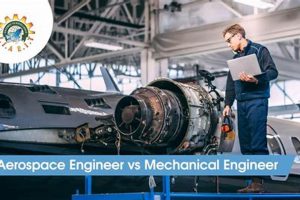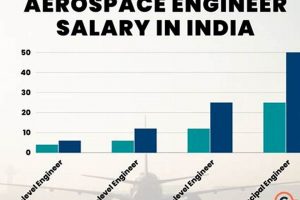The perceived difficulty of a university program in aerospace engineering is a common concern for prospective students. This concern stems from the program’s reliance on advanced mathematical and scientific principles, as well as the rigorous coursework and demanding project requirements typically associated with the discipline. The curriculum necessitates a strong foundation in physics, calculus, differential equations, and computer programming, areas that many students find challenging.
The importance of mastering these challenging concepts lies in the critical role aerospace engineers play in designing, developing, and testing aircraft, spacecraft, satellites, and missiles. Their work directly impacts the safety and efficiency of air travel, space exploration, and national defense. Historically, advancements in aerospace technology have been pivotal in shaping transportation, communication, and our understanding of the universe, contributing significantly to economic growth and scientific progress.
This analysis will delve into the specific factors contributing to the rigor of aerospace engineering curricula, including the complexities of coursework, time management demands, and the skills necessary for success. It will also explore potential support systems and strategies for navigating the challenges inherent in this demanding field of study.
Success in aerospace engineering requires dedication, effective study habits, and proactive engagement with available resources. The following strategies can help mitigate the challenges inherent in the program.
Tip 1: Solidify Foundational Knowledge: Ensure a robust understanding of core mathematical and scientific principles before advancing to more complex topics. Review calculus, differential equations, linear algebra, and physics concepts regularly.
Tip 2: Master Programming Fundamentals: Develop proficiency in programming languages such as MATLAB, Python, or C++. These tools are essential for simulations, data analysis, and control systems design.
Tip 3: Implement Effective Time Management: Create a structured schedule that allocates sufficient time for coursework, projects, and extracurricular activities. Prioritize tasks based on deadlines and importance.
Tip 4: Actively Participate in Study Groups: Collaborate with peers to enhance understanding and problem-solving skills. Study groups provide opportunities to discuss challenging concepts and share insights.
Tip 5: Seek Guidance from Professors and Teaching Assistants: Utilize office hours to clarify doubts and seek assistance with difficult topics. Professors and TAs offer valuable insights and support.
Tip 6: Engage in Hands-on Projects: Participate in research opportunities, design competitions, or club activities that provide practical experience. Hands-on projects reinforce theoretical knowledge and develop valuable skills.
Tip 7: Maintain a Healthy Work-Life Balance: Prioritize physical and mental well-being to avoid burnout. Ensure adequate sleep, exercise, and social interaction to maintain focus and motivation.
These strategies aim to equip students with the tools necessary to manage the academic demands and foster a deeper understanding of aerospace engineering principles. Consistent application of these tips can contribute significantly to academic success and professional development.
The following sections will address the long-term career prospects and potential rewards associated with pursuing a degree in aerospace engineering.
1. Mathematics proficiency
The perceived difficulty of an aerospace engineering degree is inextricably linked to a student’s mathematical proficiency. A robust understanding of mathematical concepts serves as the foundation upon which all other engineering principles are built. Deficiencies in mathematics directly translate to increased difficulty in comprehending advanced topics such as aerodynamics, orbital mechanics, and control systems, each of which relies heavily on mathematical modeling and analysis.
For example, calculating the trajectory of a spacecraft requires a strong grasp of differential equations and linear algebra. Similarly, designing an aircraft wing that maximizes lift and minimizes drag necessitates proficiency in calculus and computational fluid dynamics. Without adequate mathematical skills, students struggle to grasp the underlying principles, hindering their ability to solve problems, analyze data, and design effective aerospace systems. This lack of proficiency extends beyond theoretical understanding, impacting the ability to utilize simulation software and interpret complex datasets generated from experiments or simulations.
In conclusion, mathematical proficiency is not merely a prerequisite for aerospace engineering; it is a fundamental determinant of a student’s ability to successfully navigate the curriculum. Mastering mathematical concepts is essential for grasping the core principles of the field and translating theory into practical application. Insufficient mathematical skills significantly elevate the challenge, impeding comprehension and hindering progress throughout the degree program.
2. Computational complexity
Computational complexity is a significant contributor to the perceived difficulty of an aerospace engineering degree. The field inherently involves the analysis and simulation of intricate systems, requiring substantial computational resources and expertise. This complexity manifests in various aspects of the curriculum, directly impacting the time and effort required for successful completion. The ability to effectively utilize and understand computational tools is no longer a supplementary skill, but a core competency for aerospace engineers.
The impact is evident in areas like computational fluid dynamics (CFD), where simulating airflow around an aircraft requires solving complex Navier-Stokes equations. Structural analysis, employing finite element methods (FEM), also demands extensive computational power to model stress and strain distributions within aerospace structures. Control systems design relies on simulations to validate stability and performance. These simulations often involve millions of calculations and require specialized software knowledge. Moreover, processing data from wind tunnel experiments or flight tests adds another layer of complexity, demanding skills in data analysis and visualization. For example, accurately predicting the aerodynamic performance of a new aircraft design necessitates intensive CFD simulations, the results of which are then used to refine the design iteratively. Failure to adequately grasp these computational aspects directly impedes a students ability to analyze, design, and optimize aerospace systems.
In essence, mastering the computational tools and techniques necessary for aerospace engineering is a challenging but crucial endeavor. The inherent computational complexity significantly increases the demands of the degree. However, a strong foundation in computational methods enables aerospace engineers to tackle real-world problems, develop innovative solutions, and contribute to advancements in the field. Therefore, recognizing and addressing the computational challenges is paramount for students seeking success in aerospace engineering.
3. Demanding coursework
The intense curriculum inherent in an aerospace engineering degree is a primary determinant of its difficulty. The coursework demands a high level of understanding and application of complex scientific and engineering principles across multiple disciplines. This breadth and depth of knowledge required contribute significantly to the overall challenge of the program. The demanding nature of the coursework stems from the need for aerospace engineers to design, develop, and test systems operating in extreme environments and under strict performance requirements. Each course builds upon previous knowledge, creating a cumulative effect that requires consistent effort and dedication.
Examples of demanding courses include aerodynamics, which requires mastery of fluid dynamics and thermodynamics to analyze airflow around aircraft and spacecraft; structural analysis, necessitating a firm grasp of mechanics of materials and finite element methods to design lightweight and robust structures; propulsion, demanding understanding of combustion and heat transfer to design efficient and reliable engines; and control systems, requiring knowledge of feedback control theory and signal processing to ensure stability and performance of flight vehicles. Successfully navigating these courses requires not only theoretical knowledge but also the ability to apply these principles to solve practical problems and design real-world aerospace systems. For example, designing a stable and efficient aircraft requires the integrated application of aerodynamics, structural analysis, propulsion, and control systems, highlighting the interconnected nature and cumulative demands of the coursework. The practical significance lies in the ability to produce competent engineers capable of addressing contemporary challenges in air and space exploration.
In conclusion, the demanding coursework of an aerospace engineering degree is a central component of its overall difficulty. The need to master complex scientific and engineering principles, the cumulative nature of the curriculum, and the requirement to apply these principles to practical problems collectively contribute to the rigorous demands of the program. A comprehensive understanding of this connection is crucial for prospective students to realistically assess the challenges and prepare effectively for the demands of this field of study.
4. Time commitment
The substantial time commitment associated with an aerospace engineering degree significantly contributes to its perceived and actual difficulty. The curriculum demands extensive hours devoted to coursework, projects, and independent study, posing a considerable challenge for students to manage effectively.
- Coursework Load
Aerospace engineering curricula typically encompass a wide range of demanding courses, each requiring significant time for lectures, readings, and assignments. The sheer volume of material necessitates diligent study habits and efficient time allocation. For instance, a student may spend upwards of 15-20 hours per week solely on coursework for a single advanced engineering class. This intense workload directly impacts the available time for other activities, including personal pursuits and extracurricular involvement, increasing the overall stress and difficulty of the degree.
- Project-Based Learning
A hallmark of aerospace engineering education is its emphasis on project-based learning. These projects, often involving complex designs and simulations, demand substantial time investment. For example, a team designing a small-scale aircraft may spend hundreds of hours over a semester conceptualizing, modeling, building, and testing their prototype. These projects frequently require working outside of regular class hours and collaborating with team members, further increasing the time commitment and the potential for scheduling conflicts.
- Laboratory Work
Aerospace engineering requires hands-on experience in laboratory settings. Experiments involving wind tunnels, materials testing, and electronics often necessitate lengthy periods of preparation, execution, and data analysis. These labs often have limited availability, requiring students to schedule their time meticulously. Successfully completing lab reports and drawing meaningful conclusions from the data can further extend the time required, thus contributing to the overall workload.
- Independent Study and Research
Beyond formal coursework and projects, successful aerospace engineering students often engage in independent study to deepen their understanding of core concepts. This may involve reading research papers, exploring advanced topics, or participating in undergraduate research opportunities. Such independent exploration requires a significant time investment and can be particularly challenging for students already burdened by a heavy workload. The additional time spent acquiring specialized knowledge contributes to both the difficulty and the rewards of the degree.
In summary, the extensive time commitment associated with an aerospace engineering degree encompasses coursework, projects, laboratory work, and independent study. These elements combine to create a demanding schedule that requires diligent time management and unwavering dedication. The ability to effectively balance these competing demands is crucial for students seeking to successfully navigate the challenges and rewards of this rigorous field of study, ultimately defining the experience of “how hard is an aerospace engineering degree.”
5. Project rigor
Project rigor constitutes a significant factor in assessing the difficulty of an aerospace engineering degree. The demanding nature of these projects requires students to apply theoretical knowledge to practical problems, often under realistic constraints and with significant consequences for success or failure. This aspect of the curriculum serves as a critical test of a student’s ability to synthesize information and function effectively within a team environment.
- Scope and Complexity
Aerospace engineering projects typically involve complex designs, simulations, and analyses. For instance, a project might require designing an aircraft wing that meets specific aerodynamic and structural performance criteria, or developing a control system for a satellite that maintains precise orbital positioning. These tasks demand a comprehensive understanding of engineering principles and the ability to integrate multiple disciplines. The sheer scope and complexity of these projects necessitate substantial time investment and diligent problem-solving skills. The integration of computational tools, such as CFD and FEA software, further elevates the intellectual demand.
- Realistic Constraints
Project rigor often stems from the imposition of realistic constraints, such as budgetary limitations, material availability, and regulatory requirements. Students are forced to make trade-offs and optimize their designs within these limitations. For example, a project team tasked with building a drone might need to select cost-effective components while still meeting stringent performance specifications. The need to balance conflicting requirements and find innovative solutions under pressure significantly increases the challenge of the project. Consideration to economic and environmental aspects adds another layer of complexity.
- Teamwork and Collaboration
Aerospace engineering projects frequently involve collaborative efforts among students with diverse skill sets. Effective teamwork is essential for success, requiring clear communication, shared responsibility, and conflict resolution. Teams must coordinate their efforts to ensure that all project components are integrated seamlessly. Inefficient teamwork can lead to delays, errors, and compromised project outcomes. The ability to work effectively in a team environment is a crucial skill for aerospace engineers in their future careers.
- Evaluation and Assessment
Project rigor also arises from the stringent evaluation and assessment criteria used to grade student work. Projects are typically assessed based on technical merit, design innovation, adherence to specifications, and the quality of the final report or presentation. Students must demonstrate a clear understanding of their design choices and be able to justify their decisions with supporting data and analysis. The high standards for evaluation ensure that students are adequately prepared for the demands of professional engineering practice. Detailed documentation of the design process and performance metrics are often required for validation.
These facets of project rigor, including scope and complexity, realistic constraints, teamwork and collaboration, and stringent evaluation criteria, significantly contribute to the overall difficulty of an aerospace engineering degree. The ability to successfully navigate these challenges demonstrates a student’s readiness to enter the field and contribute meaningfully to the advancement of aerospace technology. Successfully completing these projects becomes a tangible demonstration of applied skills and an indicator of a student’s ability to handle real-world engineering challenges, solidifying the assessment of “how hard is an aerospace engineering degree.”
Frequently Asked Questions
The following questions address common concerns regarding the challenges associated with pursuing a degree in aerospace engineering. The information provided aims to offer clarity and realistic expectations for prospective students.
Question 1: Is extensive mathematical aptitude a prerequisite for success in aerospace engineering?
A strong foundation in mathematics is crucial. Calculus, differential equations, and linear algebra form the basis for understanding fundamental principles in aerodynamics, structural analysis, and control systems. While inherent aptitude is beneficial, dedicated effort and consistent practice can compensate for initial weaknesses.
Question 2: How significant is the role of computer programming in the aerospace engineering curriculum?
Computer programming is integral to the field. Students utilize programming languages such as MATLAB, Python, and C++ for simulations, data analysis, and control systems design. Proficiency in programming allows for the effective modeling and analysis of complex aerospace systems.
Question 3: What level of time commitment should one expect when pursuing an aerospace engineering degree?
A substantial time commitment is required. Expect to dedicate significant hours to coursework, projects, and independent study. Effective time management and prioritization are essential for balancing academic demands and personal life.
Question 4: Are collaborative projects a common component of aerospace engineering programs?
Collaborative projects are frequently incorporated into the curriculum. These projects provide opportunities to apply theoretical knowledge to practical problems, develop teamwork skills, and learn from peers with diverse expertise. Effective communication and collaboration are vital for project success.
Question 5: How can students effectively manage the stress associated with a demanding aerospace engineering curriculum?
Maintaining a healthy work-life balance is crucial for managing stress. Prioritize physical and mental well-being through regular exercise, adequate sleep, and social interaction. Seeking support from professors, teaching assistants, and peers can also help alleviate stress and improve academic performance.
Question 6: To what extent does the complexity of aerospace systems contribute to the difficulty of the degree?
Aerospace systems are inherently complex, involving the integration of multiple disciplines. Understanding these complex systems requires a holistic approach and the ability to apply knowledge from various areas of engineering. The complexity of these systems presents a significant challenge, but also provides opportunities for innovation and problem-solving.
In summary, navigating the challenges of an aerospace engineering degree demands a strong foundation in mathematics and programming, a significant time commitment, effective collaboration skills, and proactive stress management. Recognizing these factors is essential for prospective students to adequately prepare for the rigor and rewards of this demanding field.
The following section will summarize the key factors that contribute to the difficulty and offer insights for overcoming these challenges.
How Hard Is an Aerospace Engineering Degree
This exploration has highlighted that the perceived and actual difficulty is a multifaceted issue. Success necessitates a strong foundation in mathematics and computer programming, coupled with effective time management and collaborative skills. Demanding coursework and rigorous projects require a significant time commitment and the ability to apply theoretical knowledge to practical problems. The complexity of aerospace systems and the need to adhere to stringent constraints further elevate the challenges.
Prospective students should carefully consider these factors when evaluating their suitability for this demanding field. A realistic assessment of one’s strengths and weaknesses, combined with a proactive approach to seeking support and developing effective study habits, is essential for navigating the challenges. The rewards of contributing to advancements in air and space travel, coupled with the intellectual stimulation of solving complex engineering problems, offer a compelling motivation for those willing to embrace the rigorous demands of an aerospace engineering education.



![Top Country for Aerospace Engineering? [A Guide] Innovating the Future of Flight with Reliable Aviation Solutions Top Country for Aerospace Engineering? [A Guide] | Innovating the Future of Flight with Reliable Aviation Solutions](https://mixaerospace.com/wp-content/uploads/2025/11/th-785-300x200.jpg)



